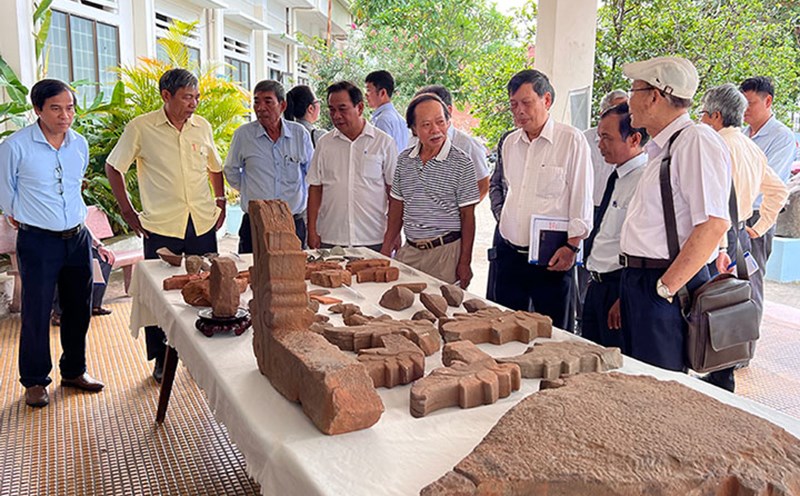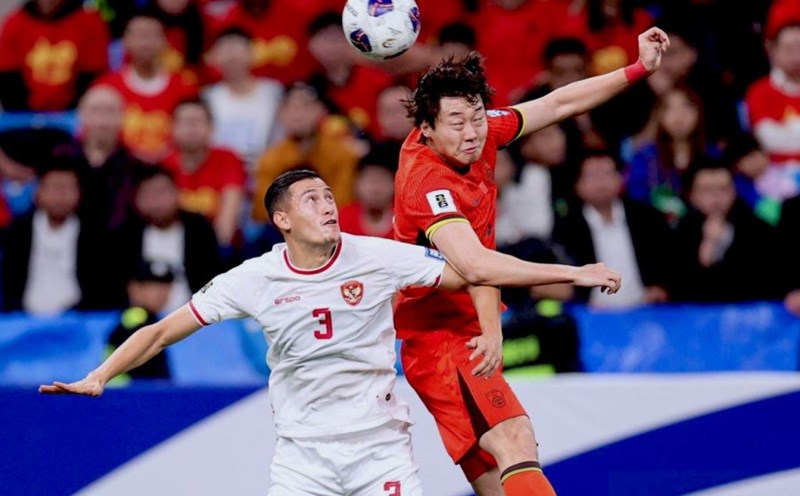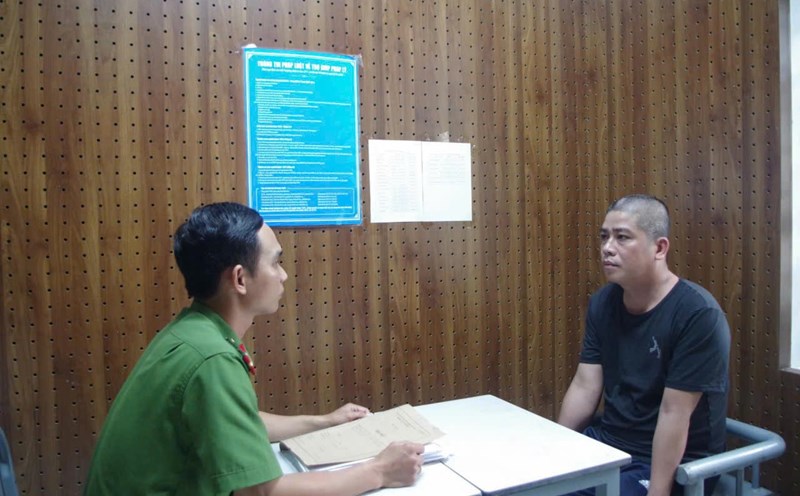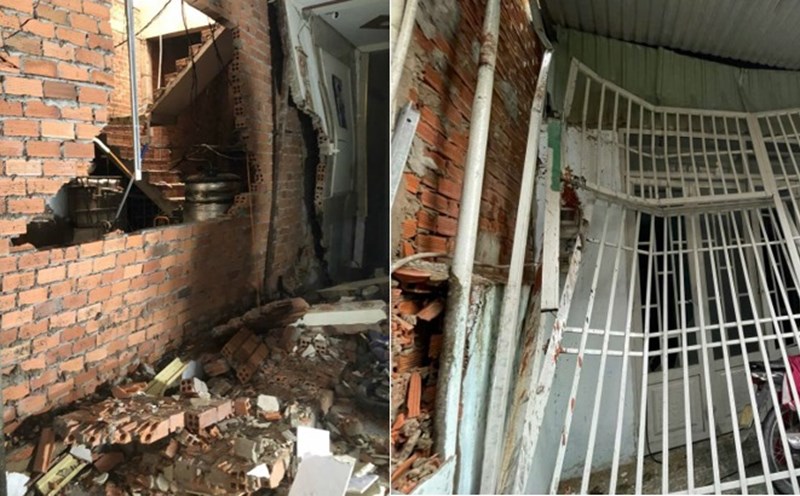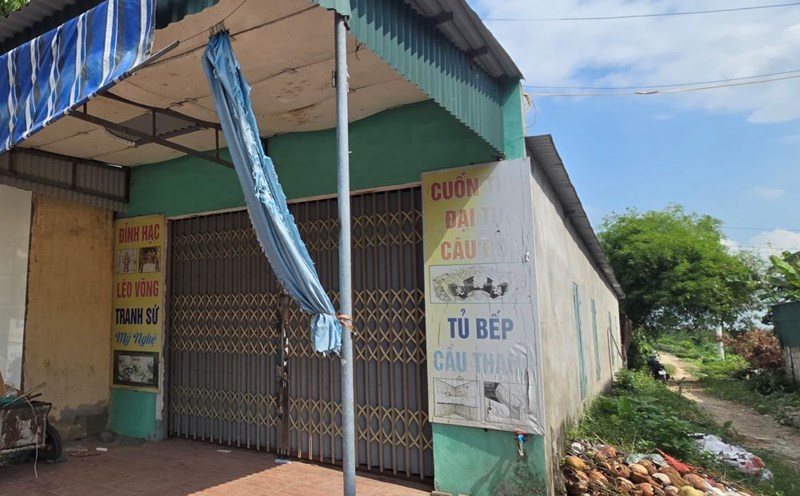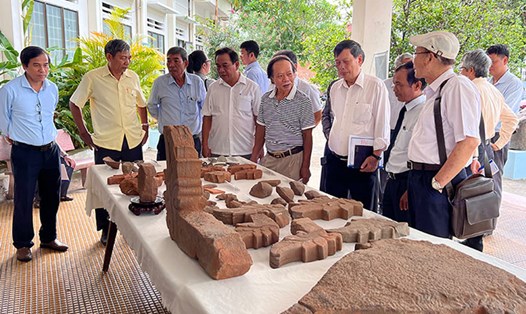Magnificent size, diverse artifacts
Dai Huu was first known through the work “Statistics and description of Cham relics in An Nam” by Henri Parmentier, published in 1909. The description from the French researcher stopped at the faint traces, the “collapsed” ruins above.
In early 2023, Binh Dinh Museum coordinated with the Vietnam Institute of Archaeology to excavate Dai Huu with an area of 200m2, revealing part of the northern, southern and eastern tower walls, and at the same time collecting many valuable artifacts such as sandstone altar pieces, stele fragments, Siva statue heads, decorative artifacts...
According to Dr. Pham Van Trieu (Institute of Archaeology), excavation results show that Dai Huu was originally a large, complete architectural complex, including religious temples and towers of the Champa people. However, information and data are not enough to evaluate, because the scope of exposure is still limited.
The second excavation, from May to July 2024, expanded the area by 300m2, revealing the entire body of the tower, the foundation of the eastern lobby, the foundation of the northern pedestal, and part of the foundations on the southern and western sides.
The image of Dai Huu tower has become clearer. The tower has a square plan with a body measuring 9.8 x 9.8m; the base foundation is 12.7 x 12.7m; the entrance to the East has a 6.42m long lobby. In particular, this excavation found a sacred pit inside the tower, measuring 3.8 x 3.8m, 1.24m deep. The sacred pit is the central item, where the first ritual took place during construction and is the most sacred place of the majestic ancient tower.
Dr. Pham Van Trieu concluded: "Dai Huu ruins are the remaining traces of a large-scale Champa tower architecture of the Vijaya land in history."
Dai Huu provides archaeological research and museum activities with 156 stone artifacts of various types and sizes, including altar pieces, inscriptions, ear-shaped leaves, decorative stone corners, human reliefs, animal statues, lotus-shaped reliefs, stone mortars and pestles. Terracotta materials are more abundant, 522 artifacts, not including bricks. We can mention ceramics with decorative corners, leaf-shaped roof tiles, animal reliefs, household ceramics (including Champa ceramics, Vietnamese ceramics, Japanese and Chinese ceramics).
“The heyday of Champa pottery”
The archaeological discovery in Dai Huu has brought many new and interesting insights. While researcher Nguyen Thanh Quang expressed dissatisfaction with the small scale of excavation compared to a large architectural complex, former Director of Binh Dinh Museum Dang Huu Tho was surprised by the series of artifacts confirming the life and activities of the ancient Champa people. "Up to now, we have mainly found traces of worship, prayers, religion and spirituality," Mr. Tho said excitedly.
The preservation of hundreds of household ceramic artifacts of “multinational” origin reflects the prosperity and open commercial atmosphere of the era.
Dr. Le Dinh Phung - Member of the Vietnam Archaeological Association - commented: "Dai Huu inherited the quintessence of Tra Kieu sculpture art, combined with Khmer culture. This was the heyday of Champa pottery, associated with bustling import and export activities through Thi Nai port. The time of the powerful Thi Nai political forces".
Presiding over the excavation, Dr. Pham Van Trieu explained more specifically: “The sacred pit and sacred pillars bear the strong imprint of religious architecture of Indian culture. The ruins inherit the Champa architectural art through a square plan, the main material is brick, combined with the use of new materials from Khmer culture, laterite.
The architectural decoration also bears the Thap Mam style, a Champa sculpture influenced by Khmer art. The discovery of breast-shaped altar pieces shows the existence of the Uroja worship (in Cham, meaning female breast), reflecting the indigenous Mother Goddess worship belief.

